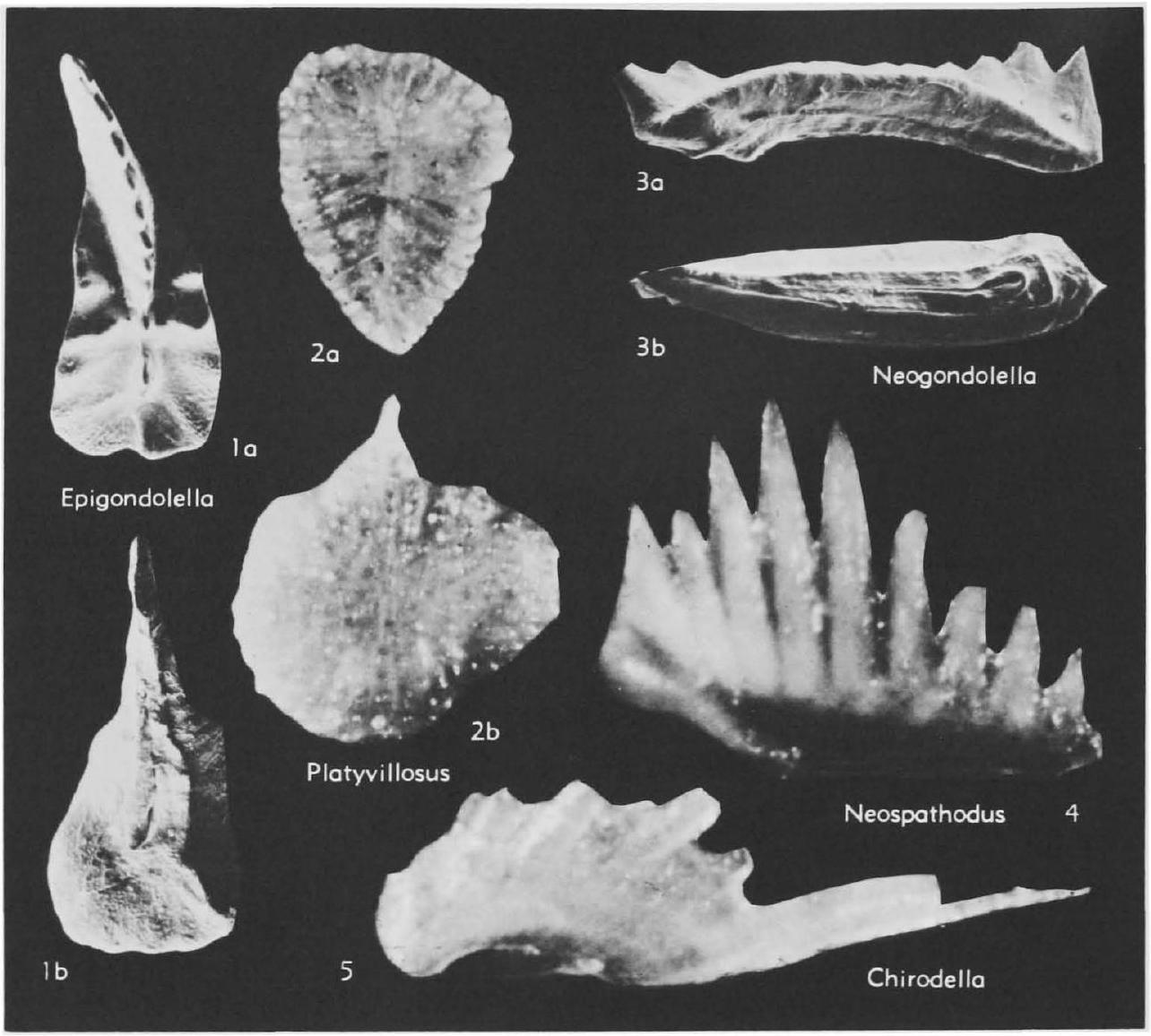Welcome to the Treatise on Invertebrate Paleontology!
Please enter a genera name to retrieve more information.

Epigondolella
Classification
Phylum:
Conodonta
Class:
Conodonta
Order:
Conodontophorida
Superfamily:
Gondolellacea
Family:
Xaniognathidae
Formal Genus Name and Reference:
Epigondolella MOSHER, 1968, p. 935
Type Species:
Polygnathus abneptis HUCKRIEDE, 1958, p. 156, OD
Images
(Click to enlarge in a new window)
Fig. 105, 1. *E. abneptis (Huckriede), M.Trias., Eu. (Aus.), l a, upper side, 1 b, under side, X61 (Sweet, n )
Synonyms
Tardogondolella; Ancyrogondolella; Parvigondolella; Carinella
Geographic Distribution
Eu.-Asia-N.Am.
Age Range
Beginning Stage in Treatise Usage:
M.Trias.
Beginning International Stage:
Anisian
Fraction Up In Beginning Stage:
0
Beginning Date:
246.7
Ending Stage in Treatise Usage:
U.Trias.
Ending International Stage:
Rhaetian
Fraction Up In Ending Stage:
100
Ending Date:
201.36
Description
Apparatus unimembrate, apparently composed entirely of segminiplanate elements with more or less free anterior blade and platform margins marked by node- or spinelike projections or denticles (developed from pair of dentieles projecting laterally and directed posteriorly). [Prominent zones of recessive basal margin apparently developed along a straight or bifurcate axis posterior to basal pit in intermediate to late stages of growth. Elements representing such growth stages were referred to Ancyrogondolella and Carinella by BUDUROV and have been included in Gladigondolella by some other authors. KOZUR & MOCK based Parvigondolella on platformless segminate elements interpreted as representatives of a species derived from E. bidentata MOSHER. Platform reduction, however, was evidently a phylogenetic tendency in Epigondolella, hence Parvigondolella is here regarded as merely the ultimate stage in the evolution of Epigondolella, not as a separate genus.]
References
Museum or Author Information
Classification
Phylum:
Conodonta
Class:
Conodonta
Order:
Conodontophorida
Superfamily:
Gondolellacea
Family:
Xaniognathidae
Formal Genus Name and Reference:
Epigondolella MOSHER, 1968, p. 935
Type Species:
Polygnathus abneptis HUCKRIEDE, 1958, p. 156, OD
Images
(Click to enlarge in a new window)
Fig. 105, 1. *E. abneptis (Huckriede), M.Trias., Eu. (Aus.), l a, upper side, 1 b, under side, X61 (Sweet, n )
Synonyms
Tardogondolella; Ancyrogondolella; Parvigondolella; Carinella
Geographic Distribution
Eu.-Asia-N.Am.
Age Range
Beginning Stage in Treatise Usage:
M.Trias.
Beginning International Stage:
Anisian
Fraction Up In Beginning Stage:
0
Beginning Date:
246.7
Ending Stage in Treatise Usage:
U.Trias.
Ending International Stage:
Rhaetian
Fraction Up In Ending Stage:
100
Ending Date:
201.36
Description
Apparatus unimembrate, apparently composed entirely of segminiplanate elements with more or less free anterior blade and platform margins marked by node- or spinelike projections or denticles (developed from pair of dentieles projecting laterally and directed posteriorly). [Prominent zones of recessive basal margin apparently developed along a straight or bifurcate axis posterior to basal pit in intermediate to late stages of growth. Elements representing such growth stages were referred to Ancyrogondolella and Carinella by BUDUROV and have been included in Gladigondolella by some other authors. KOZUR & MOCK based Parvigondolella on platformless segminate elements interpreted as representatives of a species derived from E. bidentata MOSHER. Platform reduction, however, was evidently a phylogenetic tendency in Epigondolella, hence Parvigondolella is here regarded as merely the ultimate stage in the evolution of Epigondolella, not as a separate genus.]
